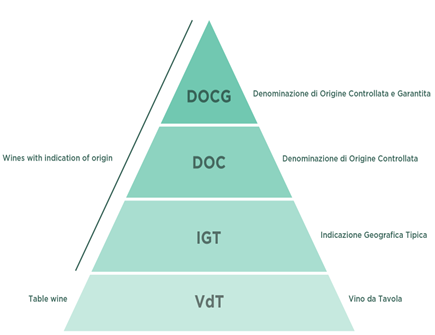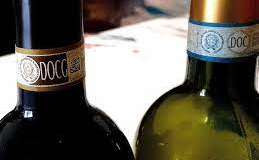The Evolution of Wine Designations: From Ancient Amphorae to Modern DOCG


Wine designations, also known as denominations of origin, are a cornerstone of the wine industry, ensuring quality, authenticity, and a sense of place. These designations protect the names of wines based on their geographic origin, much like the appellation systems in France and Italy. Established in Italy in 1963 with the introduction of Law 930, the concept of denominazione di origine controllata (DOC) and later denominazione di origine controllata e garantita (DOCG) has been pivotal in preserving the integrity and heritage of Italian wines. These systems ensure that wines labeled with specific regional names adhere to strict production standards, highlighting the unique characteristics imparted by their terroir.
A few years after the fiftieth anniversary of the first Italian law protecting wine designations of origin (D.P.R. 930/1963), I am reintroducing the interesting contribution on the topic written by Professor Mario Fregoni as an introduction to the volume "50 DOC – 50 years of designations of origin protecting Italian wine," published by Ci.Vin in 2013.
On ancient wine amphorae, the name of the production place, the owner, and the vintage were inscribed. The use of the geographical name to indicate the wine dates back to ancient civilizations. In fact, the genius loci of various Egyptian, Armenian, Syrian, Lebanese, Israeli, Greek, and many Roman crus (over 60 geographic names such as the famous Falernum, Cecubo, Albano, Mamertino, Pompeiano, Pucino, etc.) are known. This tradition extended to Burgundy (in 1000, the Benedictines classified the current crus), mentioned by Pope Paul III Farnese in 1549, whose sommelier Sante Lancerio illustrated the wines the Pope desired in different circumstances. A precious and precise work on the subject is the encyclopedic work of Bacci (1596), the Pope's doctor, which lists 44 geographical denominations used to indicate wines. The first official legal recognitions came with the decrees of Hungarian Tokay (1700), Chianti (the current Classico area) (1713), Marsala (1773), and the various classes of Bordeaux crus (1885). The first state law was approved by France in 1935, although in this country, several denominations were already in use on a regional scale. Italy started with typical wines in 1937 (but they were a disappointment) and then approved the first law on controlled and guaranteed denominations of origin (DOC and DOCG) in 1963, with number 930.
When did the use of varietal names to indicate wine begin in Italy? This choice can be placed towards the end of the 1600s, the beginning of the 1700s. It is true that the Romans distinguished the "aminee" (neutral) and the "apiane" (aromatic, like Moscati) and some others, but they did not use the names to "label" the wines, as the varieties were mixed in the vineyards, even with wild grapes (Vitis Sylvestris), a tradition that certainly continued into the 1700s according to bibliographic sources. The wines were the result of blending multi-varietal populations and wild grapes. Historically, therefore, the terroir, that is, the production environment and the man who governed it, was of greater importance. Modern denominations (VQPRD, now DOP) have these historical bases. Nevertheless, in recent centuries, particularly in Italy and the New World, the custom of naming wine after the variety has taken over. A worldwide survey by the author revealed that about 20% of international wines bear only the variety name (New World, but recently also allowed by the European Union); about 10% of the world's wines are labeled with only the geographic name (in Europe, such as Barolo, Chianti, various Bordeaux Chateaux, Burgundy crus, etc.); finally, 70% of wines are labeled jointly with the variety and the production area name (in Italy and other European countries). We must ask ourselves which line to follow. The valorization and protection of the name of the terroir or the varietal? It should be noted that DOPs are protected in the EU and many European countries, while in other competing or consumer countries, geographic origin designations can be registered as trademarks. Conversely, the variety is stateless and can be cultivated worldwide, using its name on the bottle. In the 1900s, world viticulture was occupied by a small number of Northern European varieties, especially French (called international), while thousands of native varieties of Eastern origin were lost because they were not cultivated. A sensory analysis by a tasting panel revealed that it is difficult to recognize the variety used for a wine, and the same happens for consumers, while the terroir is easier to identify. Moreover, the terroir is inimitable because it is not transferable, while the variety can be cultivated in all countries of the world, so much so that the concentration on a few international varieties (e.g., Bordeaux varieties) is producing many similar wines globally (widespread isosensoriality), especially with the repetition of modern winemaking technology across all continents. Therefore, we must focus on terroir wines endowed with the typicality impressed by environmental factors (soil and climate). There are quality varieties that give highly typical wines only in great terroirs: e.g., Sangiovese in Montalcino, Nebbiolo in Barolo, and so on. The terroir should be proposed not only through the geographical name of large territories but especially with the names of the "additional geographical mentions," represented by microzones or well-known estates. Recent examples include Barolo, which has officially introduced about 180 small geographic names into its regulations, while Barbaresco has introduced about half. Without modifying the regulations, the names of estate toponyms associated with the term "vineyard" can be included on the label. But it is clear that DOPs must protect and ensure quality and sensory typicality, prerogatives that do not always coincide. The former is now widespread because viticultural and winemaking technology allows avoiding defects and achieving good standards worldwide, while typicality is more difficult to obtain because it is the result of the interaction between the valuable variety and the environment (soil and climate), i.e., a class terroir that provides rare, inimitable wines.
Italian laws on denominations of origin: 1963, 1992, 2010
Law 930/63 was a major turning point in the Italian viticultural landscape, which at that time was marked by much fragmentation of farms, confusion in viticultural management, and widespread fraud that multiplied wine production, reaching 80 million hectoliters and consequently leading to the wine war with France, to which we exported 7 million hectoliters of blending wines, replacing those from North African countries that had become independent from France. Law 930/63 laid the foundations for denominations of origin, imitating French legislation on AOCs. It introduced the concept of a delimited and intangible production area for each DOC, the production regulations with all the rules on varieties, allowed viticultural techniques, and winemaking techniques. It provided for two levels of denomination of origin, namely DOC and DOCG, with the possibility of opting out of the "G" to declare everything in the underlying DOC in case of unfavorable vintages. About twenty years after 930/63, then Minister of Agriculture Mannino entrusted the author, then President of the National Committee for Designations of Origin, with the task of renewing and updating the existing law. The first innovation concerned the definition of DOC, missing in 930/63, which still contemplates two essential principles: the quality and notoriety of the wine, obviously produced in a delimited geographical area that bears its name. The other proposal concerned the expansion of the levels of denominations of origin: above DOCG, microzones were introduced, and at the top, the "vineyard" aggregated to the name of the cadastral toponym. Below DOC, IGTs (typical geographical indications) were envisaged, in turn placed at a level higher than table wines without a geographical name. Thus, the DOC pyramid was born. Among the various categories of wines bearing the geographical name, the harvest choice was expanded and perfected, both for qualitative vintage purposes and commercial purposes. Essentially, the high geographical levels of the DOC pyramid configure the French strategy of Burgundy crus and Bordeaux Chateaux. The "additional geographical mentions," introduced in the regulations of Barolo and Barbaresco, are nothing more than crus. The new law was presented by Minister of Agriculture Goria and, after approval by both houses of Parliament, was numbered 164/92, and a well-known journalist wrote that it "spoke Piacentino," alluding to the author. Subsequently, it was presented in other countries, so much so that Argentina approved one very similar. For completeness, it should be recalled the recent 2010 law, which did not bring conceptual innovations but only improvements on the use of the different levels of denominations of origin, already provided for in 164/92 and thus in the DOC pyramid; thus, the microzones were renamed additional geographical mentions. The concrete contribution of the first two laws on denominations of origin can be inferred from the following data: the percentage of DOC+DOCG at the time of 930/63 was around 10%, while in 2011 it rose to 35%, followed by IGTs at 26%, which 930/63 did not contemplate. Therefore, 61% of Italian production carries a geographical name of origin, that is, the name of a terroir, usually of large area. The recognized DOCs and DOCGs are 403, and the IGTs amount to 118. It is emphasized that the denominations of origin have strengthened our exports, representing 51% of Italian wine production, amounting to a substantial 4.4 billion euros, the largest voice of Italian food exports and essential for our GDP. Further appreciation of the effect of our legislation on denominations of origin can be deduced from the export prices: €3.90 per bottle for DOC-DOCG; €2.50 per bottle for IGT; €1.42 for table wine without geographical indications, and €0.47 for bulk wine. Better prices are obtained by France, Germany, Spain, and other countries, particularly for wines with denominations of origin or geographical indications. The world shows trust in regulated terroir wines, and consequently, we must focus on valuing wines bearing a geographical name, even if the EU has erroneously.
Comments
You know you want to
Sign Up For Our Newsletter
Keep up to date on the latest wine releases, events and promotions.